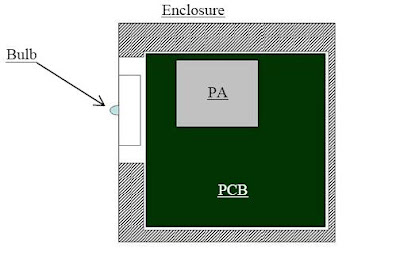This bulb is a plasma bulb.
This new bulb can give up to 140 lumens per watt. This is compared to those LED which can generate up to 70 lumens per watt, and those ordinary bulbs will generate light up to 145 lumens per watt. This new super-efficient bulb is now see to be very much more efficient than any present electrical light generation devices. The light it generates is at the temperature of 6000K.
From the video, we could see that the 250 watts Luxim plasma bulb outperforms the 400 watts bulb. This shows the efficiency that the tiny-bulb can give.
More interestingly is that the bulb does not have electrical connection to itself. It’s just a clean light bulb without terminals. What it needs is a puck (dielectric material).
 The puck will consist of RF PA (Radio Frequency Power Amplifier) and a circuit board (PCB). The puck is an electrical circuit which will generate RF signals and concentrate and focusing the signal into the light bulb. This signal energy will vaporize the contents in the bulb to plasma state, and making the bulb to generate intense light.
The puck will consist of RF PA (Radio Frequency Power Amplifier) and a circuit board (PCB). The puck is an electrical circuit which will generate RF signals and concentrate and focusing the signal into the light bulb. This signal energy will vaporize the contents in the bulb to plasma state, and making the bulb to generate intense light. This new high-efficient light bulb is clearly seen to be a new future of lighting technology. However, there’s not much mention on the environmental issues related to the design of the bulb.
This new high-efficient light bulb is clearly seen to be a new future of lighting technology. However, there’s not much mention on the environmental issues related to the design of the bulb.The Luxim super-efficient light bulb is a new challenger to the currently developing bright-LEDs. Recently there has been high investment in research and development of LEDs to compete with fluorescent lamps. Many lighting products are now diverting into LEDs. The industry of lighting is clearly seen competitive among themselves in getting most efficient technology, in terms of brightness per watt.
No matter what, technology development will never rest. It’s progressing and keep on moving, with those people who have been spending times to create things to improve lives.
A bit story of lightings:
Light is the main source of energy for photosynthesis in plants. And lights cannot be omitted in lives. We need light to see things. Moreover, we are recently trying to make use of light as a source of energy. So, that’s how important light is.
Now, talking about light bulbs; devices which generate light for the purpose of “seeing objects/things”.
Presently, we have 3 main types of light generation devices.
Fluorescent lamp: contains special gases in its enclosure which will generate light when the gas is charged up by electricity. It will require ballast to regulate power supply to the bulb.
Incandescent Lamp: contains heat element in its enclosure which will be heated when electricity is passed through the element, and hence generate light when the element is heated up to very high temperature. The lamp enclosure is filled with special gases to prevent the heat-element from destroyed through rapid oxidation.
Light Emitting Diode (LED): a semiconductor type of light generation device, which generate light by electron flows through the tiny diode. Its advantage is its ability to generate light in a narrower light spectrum. Therefore, the LEDs have different colours of light. (each colour has specific light wavelength).
Some might want to mention HID as well, but HID is similar to fluorescent lamp, in the sense that its principle is to charge up the enclosed gases to generate light. HID is applied in automotive head lights, and it’s a replacement to conventional head light bulbs. HID will require ballast as well.
Resources:
http://hardware.slashdot.org/article.pl?sid=08/03/22/2049257
http://news.zdnet.com/2422-13568_22-192842.html
http://www.engadget.com/2008/03/18/luxim-wants-to-brighten-your-block-with-ultra-powerful-plasma-li/
http://www.lifi.com/dynamic/display.php/31
http://www.lifi.com/pdfs/ArticleSID2007LUXIM-8Mar07.pdf
No comments:
Post a Comment